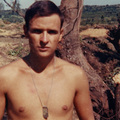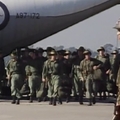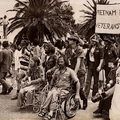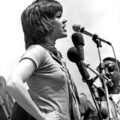"All that mattered was the work, spending time in the field and staying alive to tell the story."
Interview with Laszlo Kondor
It was in 1998 that I first heard about Laszlo Kondor when his photographs about the Vietnam War were exhibited in Budapest. A few years later I tried everywhere to contact him, but to no avail. Then, last November, I tried again and succeeded. That is how I finally met him in person after almost twenty years.
Please note: this interview was originally published here in Hungarian. At the request of several English-speaking people, we decided to publish it in English, too, to make it available to as many foreign readers as possible. This translation was made by Máté Havasi with the assistance of Linda and László Kondor.
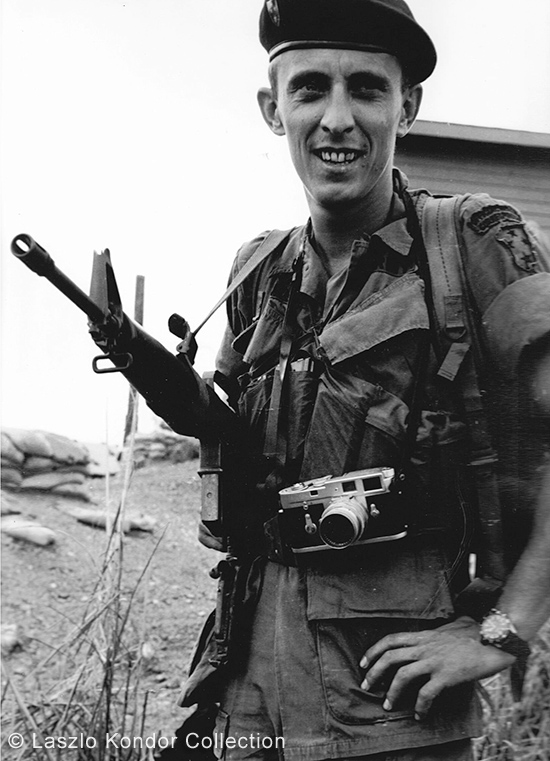
Laszlo Kondor, combat photographer,
Americal Division, Vietnam, January 1970
(With permission of Laszlo Kondor, all rights reserved)
Talking to him is quite an experience. Laszlo is 76, but he seems to be 20 years younger. He is agile, his eyes are spirited, and when he starts telling his story, he does relive those years. He talks with élan and passion. It is impossible not to listen to him. Sometimes he switches to English from Hungarian, involuntarily or just to quote a remarkable sentence.
How did this adventurous life begin?
In late November 1956, after the breakdown of the Hungarian revolution, my brother and I went to Austria. The question was where to go and what to do? First we were taken to a refugee camp at Traiskirchen. That was when I realized that Hungary had been truly separated from the world, it was a prison, literally, a dark prison. One of the surprises, in Vienna just before Christmas 1956, was Mariahilfer Strasse, because it was full of lights! That was something I had never seen, Budapest was dark at that time! The whole country was dark. And this was 1956, the Russians had withdrawn from Austria just one year earlier. It was startling for a Hungarian to see all that light, as the Austrians were still not very well-off back then.
The 1956 Revolution had a huge international impact. Much more significant than we had imagined. The whole Western world opened the gates for our immigrants, although they had not assisted the revolution itself. The consulates of these countries put up their stands in the streets and asked us where we wanted to go. There was a quota for each country of the number of immigrants. Eisenhower was the US President and the American quota was about 250 or 500 a year. He changed that to 50,000, and that was what other countries did. The places were running out, my brother and I did not want to stand in line in the winter cold, so we joined the queue at New Zealand, where only a couple of people were standing. I told my brother we would go to New Zealand become sheep farmers, then sheep ranchers. We had to get out of Europe as far as possible. But that never happened.
It is only a few times in life that divine intervention takes place. We were in a big sleeping room for at least 70. I was going out when I heard someone speaking: "I am Father József Tóth. I am here to gather those, who had their high school education interrupted, and have their school report books. They may finish their studies, here, in Austria."

The Hungarian Dormitory in Innsbruck
And so Laszlo and his brother went to Innsbruck, a Western Austrian town, the capital of Tyrol, to attend an Austro-Hungarian High School. They were taken care of and they could go on with their studies. Paul, the elder brother graduated the following summer and received a Ford scholarship in Rome; he immigrated to America two years later. Laszlo stayed in Innsbruck, finishing his high school studies, going on to Innsbruck University majoring in Psychology, while performing with a Hungarian Folk Dance Group, and skiing in winter.
It was then that I took up photography. I bought a battered 35 mm camera and learned to develop, and print. I was really keen on it. I never went to a photography course. Most famous photographers I respect never did, either. So I learned how to do it—on my own, self taught. And after a while, I was eager to get out and see the world, I found Austria had become too small. So, in April 1961, I followed my brother to the US. My brother lived outside Chicago in a town called Aurora, as a factory worker, and I joined him Immigrants were expected to work. Initially we received some allowance, but after that we had to go to work. This world was an ugly place for me, I spent some joyless months there.
Then someone asked him, why not go to university? So he sent out letters to several institutions, but to no avail, until a friend recommended University of Chicago which was one of the top universities in the world. He was lucky as they were working to shake up the place a bit: they wanted new worldly teachers as well as an international student community. The dean happened to be an avid fan of classical music just like Laszlo. He wanted to know everything about recent Viennese operas, and after a delightful conversation, was positive about his admittance. He received a four-year scholarship. But he had problems—with English. His dearest professor, Hans Morgenthau (who worked as a consultant to the Department of State under Kennedy and Johnson) helped him, sometimes in German and assigned him as a professor’s assistant.
Morgenthau opposed the American commitment in Vietnam in the early 1960s. He considered the US policy wrong: the policy makers in Washington, triumphant in World War Two, had come to believe it was the US holy mission to export and defend democracy. They were thinking that since it had worked in Europe, it should work in Africa and Asia. Why should it? NATO and the Marshall Plan gave a blood transfusion and kicked started the restoration of bled-out European countries, where western culture, tradition and democracy had existed. But to take democracy to countries where it had never existed before, Morgenthau said this was inconceivable! It simply would not function!
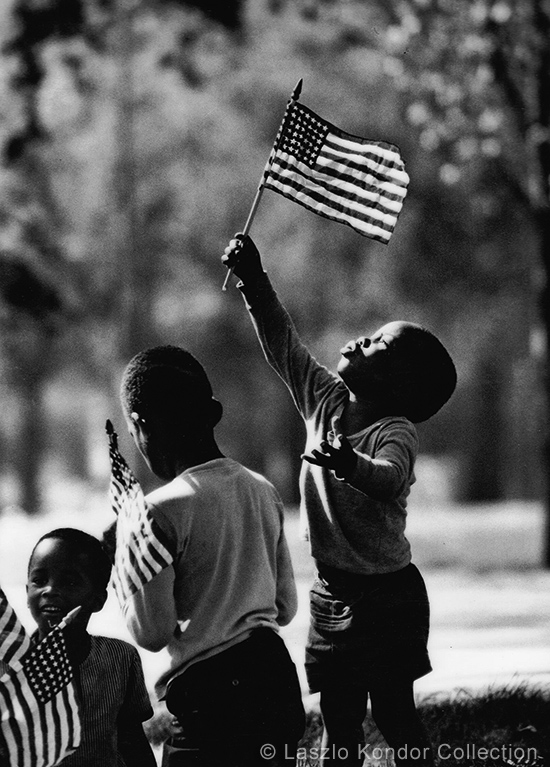
Children at the park. This picture was taken right after the 1968
Democratic National Convention in Chicago.
(With permission of Laszlo Kondor, all rights reserved)
He continued with photography, but as a freelancer. He took pictures of anti-war protests including the one during the 1968 Democratic National Convention in Chicago. This would turn out to be a sort of breakthrough.
During the convention protests, one late afternoon proved to be quite explosive. The war protesters decided to march to the convention centre, which was south of 18th Street. By then the road had been blocked by the National Guard with machine guns mounted on armoured personnel carriers. I had seen tanks in Hungary, I knew that it was a time when you had to be careful. When I got closer I looked to see if the weapons were loaded: they were, and I was really frightened. Suddenly a policeman drove through the crowd. He stopped the demonstrators and started pleading with them. I moved closer and took photographs of the whole sequence of events. He seemed to be someone important, but I would learn his name only later. He told them: ‘I'll take you back in front of the Hilton Hotel. You'll be safe, we won't bother you there, but you can't go to the convention center, it is out of my hands, they will shoot you!’
I really applauded this man's actions. He was a leader and was not afraid of being lynched by an angry mob. His decisions saved lives. The machine guns were loaded! And this was the National Guard, who would later kill student protestors at Kent State University. National Guard... We called them weekend warriors, poorly trained, overfed draft-dodgers. They were dangerous! Give me federal troops anytime! In Washington, when there was a protest march on the Pentagon, they had federal troops. They just stood there and blocked access. And the demonstrators did notice the discipline they projected.
With the convention over, there were a lot of published photos, but no one had covered this very incident. And I was curious who was this man? I called a Chicago journalist, Walter Kale. He said that man was Deputy Superintendent Rochford of the Chicago Police Department. He advised me to call Frank Sullivan, his press secretary. He was sure they would love to see my pictures. So I called Frank Sullivan. I told him everything, he asked me where I was, he sent a police car to pick me up. He saw my pictures, made a phone call, and we went over to Rochford's office. He was a huge Irishman. He looked at my pictures and said: ‘There were 1,800 newspapermen accredited to the Democratic Convention. Not a single one came up with anything to show us in a good light. We will never forget this. Can we make copies of these pictures?’ Then I went to have lunch with Frank Sullivan. He told me he was about to leave the police department to work for the Mayor of Chicago, Richard J, Daley. He added, the Mayor had no personal photographer, and maybe I could work for the Mayor’s Office. He tried but I didn't get the job, and anyway, the war was waiting for me.
The Vietnam War was reaching its peak and it was THE major photographic topic. As a rookie photographer, no matter how many news agencies or magazines he applied to, he could not get an assignment. So he decided to join the Army as they would take him to Vietnam.
So, what did I do at the age of 28? I volunteered for the US Army, they would make me a combat photographer. They told me they could not guarantee that assignment once in the Army. It was a risk, I didn’t care. In the middle of the winter, in late '68, I went to Fort Leonard Wood, Missouri, for basic training. I came from an intellectual ghetto to the Army that was a melting pot of all kinds of people. Those days, if a guy committed a not too serious crime, the judge would tell them, either they went to jail or joined the Army or the Marines. Lots of them chose the one they thought was the lesser evil...
What was in the Army like?
The two-month basic training is probably the most shocking experience in life. Later I did additional trainings, where training was much tougher, but it was not that bad. The transition from civilian life is what’s really difficult. They cut your hair, you have to do everything with strangers, it's incredible, it's traumatic!
Lots of films have been made about crazy sadistic drill sergeants... When I was there, nothing like that happened. It might have happened earlier, during the Korean War. But then, often we talked with these instructors. They had their own school they attended to become drill instructors. And they knew that 3% would be unable to finish basic training and these people were to be discharged as soon as possible. There would be 1–2% who were mentally unable, and they, too, had to leave otherwise they could burn down the barracks or kill someone. They were really professional; they knew precisely how much an average American can bear.
In fact, I did like some of those instructors. I will never forget Sergeant Kline, the Company Sergeant. He was a real gentleman. And he took care of us. I would meet him again in Vietnam, where he gave me a hug and asked: "Still alive, son? All right, just be careful!"
I still wanted to be a combat photographer, but I was assigned to be an infantryman: 11B, Eleven Bravo, Basic Infantry, Fort Gordon, Georgia. The training began at 4.30 AM. A black sergeant, 6'4" tall, 200 pounds, with a Smokey-the-Bear hat, stood there in front of us and shouted: ‘Gentlemen! I greet you! You finished basic training and you think you are soldiers because you have a little stripe that says you're a private. But I have three stripes—over and under. And gentlemen—I call you gentlemen, because the United States Congress requires me to call you gentlemen, but privately, I could call you lots of other things—if you think you are already soldiers, you ain't! You ain't sh*t yet! But you are here in Fort Gordon, Georgia, and in two months under my direction and the training cadre, you will become US Army Infantry! The best infantry in this world, you understand that? And when you finish all this training, then we will throw you a big-ass parade! You guys can clean yourselves up, put on your khaki uniforms with the insignia of crossed rifles that will proclaim you are infantrymen. And we will have a General here to salute you, with a military band. And then I will salute you, because you will have become one of us!’
The carrot and stick, all the time. They broke you down to build you up. And they are damn good about that! ‘And then I will salute you!’ he said. And when the parade took place, he stepped to us, saluted and shook our hands. We became soldiers. After that, we did some additional trainings, including one in the Jungle Warfare Training Center in Panama, and then they sent my young ass to Vietnam.
What was your first impression over there?
After a long flight we arrived in Cam Ranh Bay. A day later they put me on a C-130, a troop carrier with sixty other guys. I had orders to go to I Corps that was in the northern region of South Vietnam, to be more precise, to Chu Lai. I was assigned to the 23rd Americal Division which was the largest division with over 20,000 men. Flying in, as I looked down, there was a sprawling, gigantic basecamp made with metal roofs and sandbags. It was like a city! And there was a lot of smoke, so I asked one of the Air Force sergeants: ‘Was the base camp hit last night?’ He said, ‘Naaaw, they're burning shit.’ For with so many people, they used kerosene to burn all the excrement.
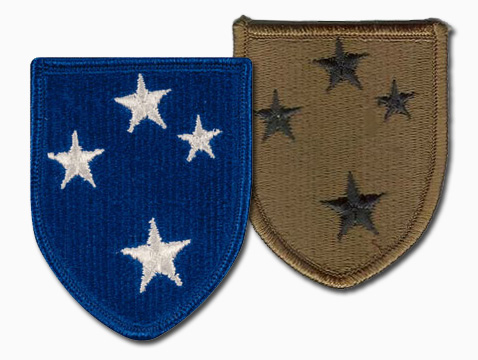
Americal Division was the only American unit in Vietnam known for its name rather than its number. It was named after the fact it was first activated in New Caledonia in 1942 and received its number only after World War Two. It was reactivated in 1967 for Vietnam service and comprised the 11th, 196th and 198th Infantry Brigades already in Southeast Asia, plus various support units. The insignia features the Southern Cross constellation and the blue colour stands for infantry.
By then I was kind of adjusted to the Army, I was over my semi-aristocratic snobbery. I was a soldier, my black sergeant said so! For one week they tried to acclimatize me, I got my new rifle, training and lectures... And I already had orders to the 11th Brigade in the south, which was, I heard, the worst area in the division. That was where the My Lai massacre had taken place a year before.(Later I was a part of the investigation into the massacre under Lieutenant-General Peers. I received a letter of commendation from him.) Within the 11th Brigade, I was to be assigned to C Company, 3rd Battalion, 1st Infantry, as infantryman, as we said, a ground-pounder or grunt! Well, my dear mother had not had that in mind for her little son, but we'll see...
So that was it? No photography and you became an infantryman?
Then came the second divine intervention of my life. There was a guy in uniform, driving around in a jeep—with a camera, talking to people, taking pictures. It turned out he was working for the division's Information Office. He was a writer, and he was taking pictures, because they didn't have a dependable photographer. Well, they had one but somehow you could never find him. He said he had only two weeks left in Vietnam and this was his last assignment. His name was Williams, a nice guy. I told him I was a dependable photographer. He was happy to hear that and suggested, we should try it. I said I had already been assigned to 11th Brigade.
'Oh, sh*t. You have your orders?'
'Sure, I got it right here.'
'Are you that naive or that dumb? That company requested 59 replacements. You know what that means? The sh*t was kicked out of them recently! That is a bad neighbourhood! But, anyway... Are you really a photographer?'
'Yes!'
'Did you work for any newspapers?'
'No, that is why I joined the Army to come here, because I didn't have experience.'
'We'll have to come up with something. We have a Major, makes all the staff decisions, I can take you up and talk to him. But you have to come up with something. If you mention a newspaper, they can check it out in five minutes.'
'How about working for the Mayor of Chicago?'
Richard J. Daley, then Mayor of Chicago was one of the powerhouses of the Democratic Party. He was a big name.
'Sh*t, yeah! He won't call the Mayor!'
Later, the major asked me if I was really an infantryman, willing to go out to take combat shots, and I said, yes sir, that's what I came for! The division paper was junk at the time. They needed something to legitimize it. That night he had dinner with the chief of staff of the division and the fix was in, I was now re-assigned, an official Combat Photographer for the Americal Division.
You know the story of Robert Capa? How the Hungarian Endre Friedmann became Robert Capa, the famous American photographer? I didn't realize that at the time but I invented myself: the famous Hungarian photographer to Mayor Daley. By the way, later I would become Daley's photographer, and I will talk about that.
I finally arrived. That was the best work of my life, those months with the Americal Division in Vietnam. I was lucky. When one arrived in Vietnam, they were assigned to a certain unit in a certain geographical area. So they saw only a small area of Vietnam. But I had a whole division to play with! It was exciting! My fame and my name grew with my credits under the pictures I took: „PFC Laszlo Kondor”. The division commander came in once saying: "That has to stop! Kondor's name cannot be printed bigger than mine!" At least he had a sense of humour...
Later we got a difficult commanding officer who didn't like my self-assigning freelance style. But I continued to go out in the field, always by chopper... And he eventually admitted he liked the stuff I got, it was good! I had a very lovely war.
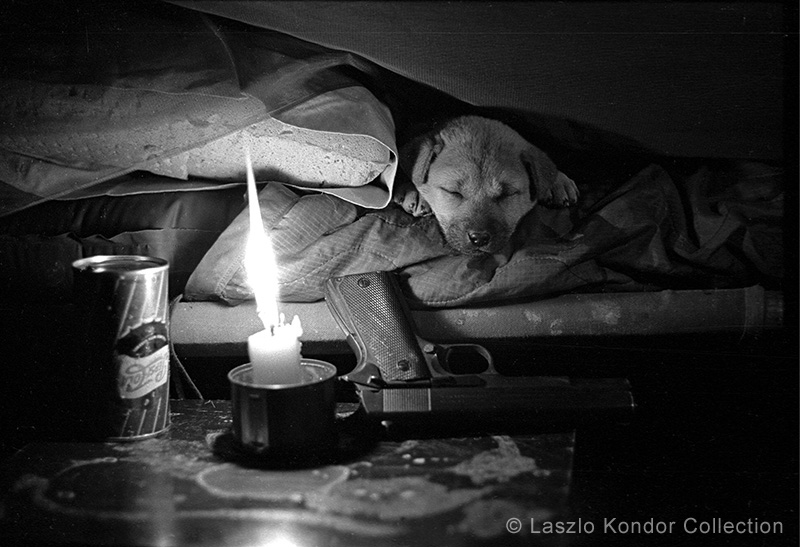
Bunker puppy on Hill 76, Christmas 1969. "This photo was published in a few hundred American papers in late '69 via AP, the Associated Press wire service. I took it at candle light, by hand, with 1/15th!"
(With permission of Laszlo Kondor, all rights reserved)
Could you continue to be a member of the soldiers' community as a photographer?
I could take pictures in a way outside press/civilian photographers could not. I had access, and they accepted me, as I wore the uniform. Once I was attached to a company and some lieutenant came up asking who I was, what I thought I was doing there? The sergeant just told him:
'Lieutenant, he is us.'
'Whaddayamean, us?'
'I mean he was with us by the time you finished OCS [Officer Candidate School].’
He is us! I blended in, when I was in a helicopter photographing them, they didn't even look at or notice me, and I was that close with a wide angle lens. This closeness gave my photos authenticity and reality. If any of my photos were good, it was partially for that reason. I used my 35 mm Leica almost exclusively. I sometimes used a Nikon but the longest lens I had was 105 mm. I photographed the soldiers. The participants. I liked that intimacy.
We had a saying in Vietnam: "When you bitch about the war, tell that to the politicians." We were like mailman. We delivered the mail, we didn't make policy. I could have said a lot of nasty things about American foreign policy, but never in front of the men I served with. And I liked those guys. That's where I became a true American citizen, a member of the American society. That's where I met the real Americans. Officially, I was not yet a US citizen! And years later, in '71, in Hawaii, my Major asked me about it. I told him. And he said a federal judge would arrive and about 500 people would receive US citizenship, including some thirty soldiers and maybe I would like to... And so, finally, I received my citizenship. It was a glorious feeling when the judge said that we, soldiers were the ones who had truly deserved this by our service.And the chopper pilots, well, I did admire them. They flew magnificently. I don't know how they did it. These 20–22 year old pilots were a fantastic bunch. And the army lost about 5,000 helicopters, so it was a really dangerous job. But when you are 20, you think you are immortal.
And the medevac pilots and crews... I still say, hats off to them! There was an officer named Anderssen, a conscientious objector. He volunteered for this duty, saying he did not want to kill but would like to be a chopper pilot. He made it. A battalion was trapped out there and he was flying above. He asked them if there was any wounded... Yes, they had plenty, but he couldn't come, they were under heavy fire. He did not care, he came in. And he did it three more times! He received the Congressional Medal of Honour. He did deserve it.
Sometimes I went out with LRRP’s [Long Range Reconnaissance Patrols] or Airborne Rangers. They were professionals, they volunteered for specialist training and service. Like neurosurgeons, they prepared meticulously as if dressing for a wedding! Everything was tied down or pulled tight to prevent rattling, their face camo painted... Their missions were usually much more dangerous, but I felt safer with them. They didn't smoke out there or tell jokes. The esprit de corps was incredible.
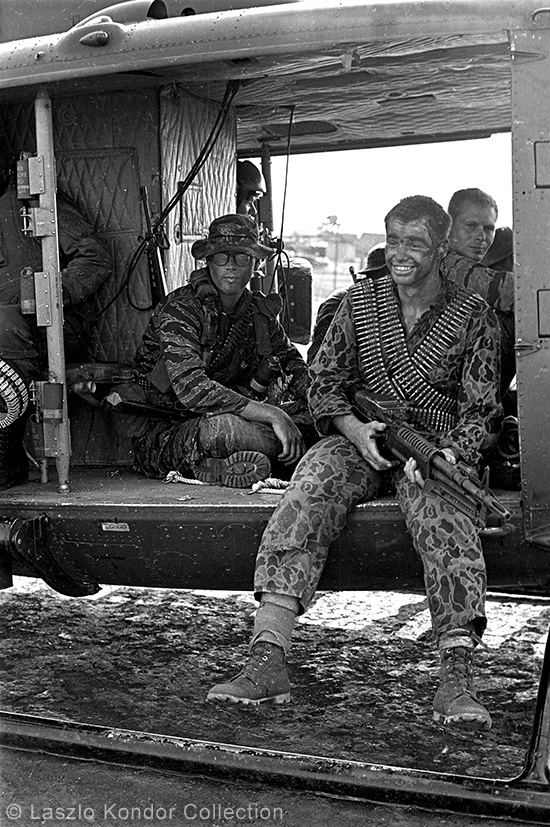
LRRP’s before deployment
(With permission of Laszlo Kondor, all rights reserved)
What was your callsign or nickname?
Well, when I was younger, I was blonde and my accent was stronger. My talk was fast and snappy. I was like a good German in the movies! Hence my first nickname: Nazi. It was not out of malice, just a name... And after a few months, I was out in the bush with some LRRP’s and someone on the radio called for Uncle. I did not respond. But they kept calling, so I called back asking who Uncle was.
'It's you!'
'I thought, I was the Nazi!'
'No, we changed that.'
And so I became Uncle. A Native American buddy of mine was called Nine-Toe as he had stepped on a mine and lost one of his toes. Serna was the Knife-Thrower. He could hit the bugs on the bunker wall with his knife.
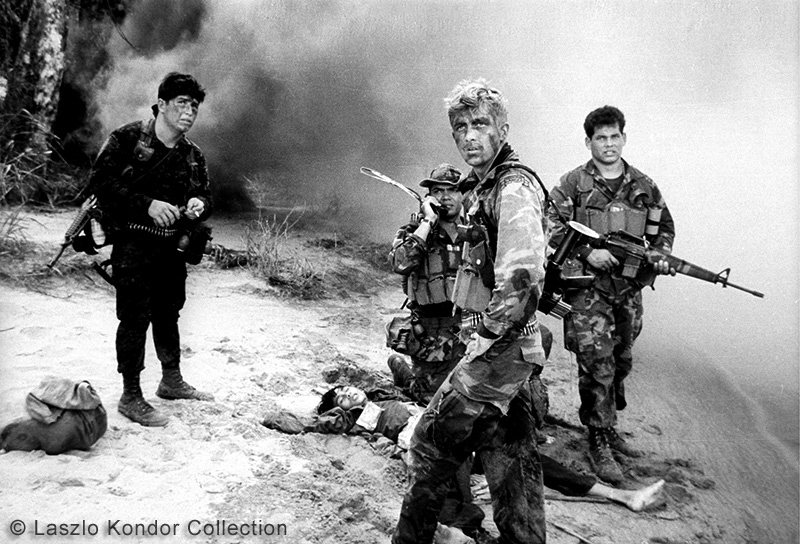
Long range recon patrol call-sign "Arkansas" waiting for the extraction
chopper. Note the wounded North Vietnamese soldier on the ground.
(With permission of Laszlo Kondor, all rights reserved)
What did you think about the enemy?
In our outfit, there was not a single soldier who did not respect them. We knew what they were capable of, how determined they were. If someone said "Charlie" or "VC", you could always hear respect in their voice. And Vietnam, the country was beautiful, the landscape breath-taking, the people friendly. Their cuisine is delicious, I love it. If we encountered them on the battlefield, we were shooting each other, but there was no hate. There isn't now. I still respect them. I wish I could meet a guerilla who was fighting at Chu Lai, on the other side, that would be interesting! We could have a long talk, and drink a few beers! He could understand what I went through much better than anyone else, because he went through the same. And after all those things I saw in the Hungarian Revolution of 1956, I did understand what it is like, to fight for your independence and so I understood them.

Vietnamese peasant at work
(With permission of Laszlo Kondor, all rights reserved)
Did you meet other famous photographers?
Yes. In Saigon, there was an old French hotel called the Continental Palace, with a huge terrace. Who was there in the evening? Soldiers, hookers and journalists. The best bunch in the world, including several well respected journalists and news photographers. I met and really liked Larry Burrows. He was a real English gentleman. Another, Horst Faas, German, a bit rude, a bit overweight, a great photographer. He won two Pulitzer Prizes, one for Vietnam, one for Bangladesh. Once I brought up the famous line of Robert Capa: "If your pictures are not good enough, you were not close enough." At that time I felt he said nothing by that. But Burrows said Capa was right and he explained:
‘In war, a soldier is under enormous physical and mental pressure. A human face is like a rubberball. Under pressure it distorts and is deformed. But when the pressure is off, it regains its shape. You have to be close to see all that. Sometimes there’s an 18-year-old kid whose face is like a 45-year-old's after one hour of combat. That is why you have to be close. Another half an hour he is once again 18, picking his nose, cleaning his rifle and smiling.’
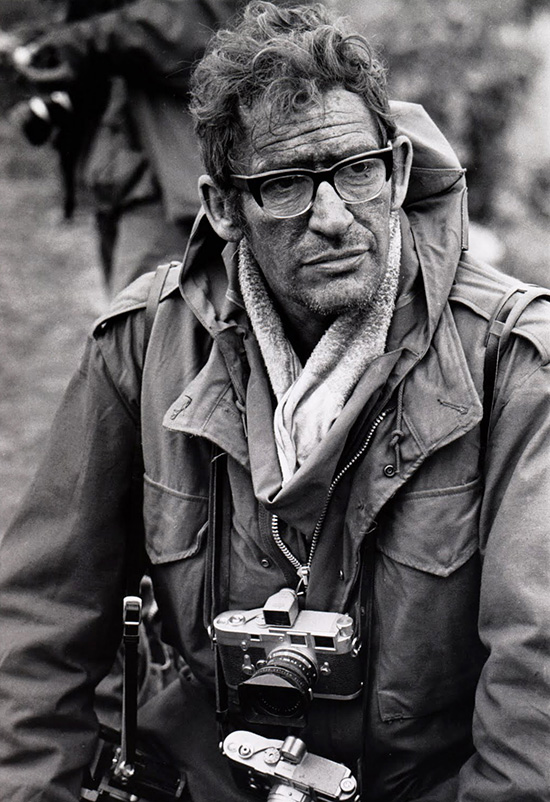
"A real English gentleman..." Larry Burrows (1926–1971) worked in Vietnam several times between 1962 and 1971 for Life Magazine. This picture was taken three days before his death in Vietnam by Roger Mattingly.
I was there when Burrows died. It happened in Khe Sanh, at the old marine base, on 10th February 1971, during Operation Lam Son 719. The South Vietnamese were going in to Laos to cut off the Ho Chi Minh Trail. Americans were prohibited to enter Laos. One of our officers said: ‘We're sending them to die. They don't have a chance.’
Burrows was on the chopper—I wanted to get in, but as an American soldier, I was not allowed. With Larry, there were three other famous photographers: Henri Huet (a French-Vietnamese guy), Kent Potter (American) and Keizaburo Shimamoto (Japanese). They took off and soon they were all dead. North Vietnamese anti-aircraft fire hit them.
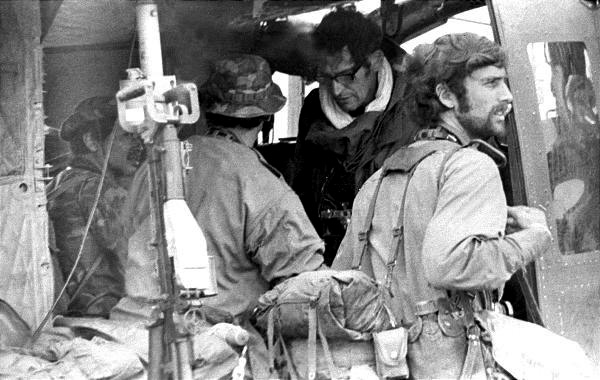
The four famous photographers, Shimamoto, Huet, Burrows and Potter boarding a UH-1. A few minutes later the chopper was shot down over Laos. Photo by Sergio Ortiz.
Did you meet fellow Hungarians in Vietnam?
Yes and no. I can tell you about a Hungarian who saved our lives. We just talked to each other but never met. I was out in the jungle with some LRRPs, we supported a company under mortar fire. It was a perfectly executed Vietcong ambush. To make it worse, all the officers and sergeants were killed by sniper fire. Utter chaos. I just hunched down, then crawled around to find a radio. I knew we needed help and the Air Force and the choppers were always there on stand by. I found a radio operator. He was wounded and in shock. I tried to talk to him, but he could not say a word. I took the hand set and as there was nobody else to use it, I called in. And the air control in Da Nang I told them we needed assistance. And they said:
'OK, give the code.'
'What code?'
They started asking me all kinds of questions which I could not answer. Now, I always count money and curse in Hungarian, so I started shouting and cursing to tell them what to do with that code... I lost it. And then somebody answered in Hungarian:
'Who are you, asshole?'
As if I had heard God himself. I asked back in Hungarian:
'And who are you?'
It was one of the F-4 Phantom pilots cruising overhead. He asked me what was the problem? I was still cursing but this Hungarian pilot assured air control, this was no VietCong, only a Hungarian could curse that good, code or no code. He asked me to speak English so that the Air Force fellas could understand. I told him this infantry company was nailed down in an ambush. I was attached to the unit, we needed help badly and ASAFP: I gave them my serial number and everything, but in God's name, do it very fast because people are dying. He asked me a couple of questions and he had his navigator double-check all the information. To me, it seemed like years before he said: 'Coming down for a Victor Romeo.' That was visual recon. 'Coming in slow, pop yellow smoke.'
He came down 500 miles an hour, brushing the treetops ignoring the anti-aircraft fire, and said: 'Roger. I see you.'
'Do you have anything to back you up?' I asked.
'Just look to your back' he answered. 'Arriving in 30 seconds.'
And they came. A wonderful sight, about 8 Phantom jets. I told them not to drop 500 pounders, only 250 pounders and rockets.
'Are you that close?'
'Roger, damn it, that close!'
That was like 'Apocalypse Now'. They dropped them... For a second, nothing. Then the whole jungle burst out in flames. Like judgment day. But it was one hell of a feeling.
And the Air Force arrived… An excerpt from ‘Apocalypse Now’.
How did you feel in and about combat?
In combat you realize that all the monotonous and repetitive training does work. Like you disassemble and re-assemble your weapon a hundred times so that you can solve any problem in any situation, in a few seconds. If you do not sh*t your pants, which might happen, then training and survival instincts kick in and you just do it. But when it is over... My hands always started shaking and I put a cigarette in my ears or eyes instead of my mouth. Fear came out only then. I was ashamed but the other guys just laughed saying it was absolutely normal, and shoved the cigarette in my mouth.
To give you another example... We were walking across this rice paddy. We were out there in the middle of a huge open area, when suddenly we were hit by mortar fire from the forest about 300 meters away. And we knew that the first three rounds might go astray, but the fourth would come right on top of us! They would eventually zero in! And you don't have much time, but you know what they will do because you have training. So what to do? Training and survival instincts kick in. So you act. First, you size up the situation. A thousand meters of open area behind you and on both sides and the enemy is about 300 meters front. You can only go forward. And on infantry training, they teach you this: you divide into two groups, Fireteams A and B. Fireteam A opens up, firing with everything they got. And the enemy, even if they are well trained, have problems with aiming. It is incredibly difficult to hit a moving target at 100 meters away! So, A opens up, B stands up and rushes forward, zigzagging and firing. Every 20 or 30 meters, you stop and the other team comes forward. It's called the leapfrog movement. This is the foundation of a simple infantry counterattack. And you are praying at the same time. And our radio operator called for air support. The jets arrived and bombed the forest. Without the assistance of the Air Force, we would have lost the war ten years earlier. They were always there, cruising and they came down when needed.

Soldiers playing cards. "This is when the rubberball has regained its shape.
They are now 18 years old, again..."
(With permission of Laszlo Kondor, all rights reserved)
And those days when nobody shot at you?
The enemy had this trick, firing a shot every ten minutes from a distance too far to be effective, towards the patrols. Harassment fire. They almost never hit anyone. But it was damn unnerving! Once, on patrol, someone told me to drop my pack immediately. He tore open my shirt, saying I was bleeding! I thought, oh, no, one of those shooters hit me. And you know, sometimes you are hit but you can't feel a thing. If that happened, the others didn't waste their time, they tore off your shirt to find the wound, because you could bleed out really fast. Then, they started laughing: it was some leeches and I was bleeding like a pig. Millions of leeches out there... And bugs and spiders and elephants and snakes.
I was really afraid of the bamboo or five-step snake. They were hiding in the trees and fell down on your head or shoulder and would bite your neck or face. The Army had some very nice advice for that: ‘If you are bitten by the bamboo snake, you can make about five steps, then lie down in a respectable dying position.’ They didn't have an antidote.
But there was something funnier… We were at the Laotian border listening to the radio communication. We heard the most incredible dialogue, some Special Forces recce team talking to the Air Force guys.
‘Boys, you are not gonna believe this.’
‘What is that?’
‘We have eyes on a herd of pink elephants!’
‘Repeat it. What colour?’
‘Pink, at least sixty of them.’
It was the dry season. It turned out that red clay covered the elephants, it had dried on them and they seemed to be pink.
There were other dangers. If you drank foul water, you might have an intestinal infection. The Army reported infections that even the best medical research professionals had not heard of. Poor guys threw up blood at the hospital. I was lucky, all I got was malaria. I was shuddering; I thought my brains would fall out. They put me into a bathtub full of ice cubes to take down my fever. Even now, I cannot donate blood, as malaria never leaves your system.
In the monsoon season it was extremely hot and the weather changes by the hour. And the monsoon—it does not rain, it pours. One hour of rain, then the sun comes out. Humidity was close to 100 percent… You didn’t have to move to sweat. Your jacket was white with salt by the evening. And we had to take salt tablets every day. If you lost too much salt, you had these incredible cramps in your muscles. Some guys from Texas, kept insisting they did not need the tablets, they knew everything about heat. Then they were taken away on stretchers, they almost died, they were crying.
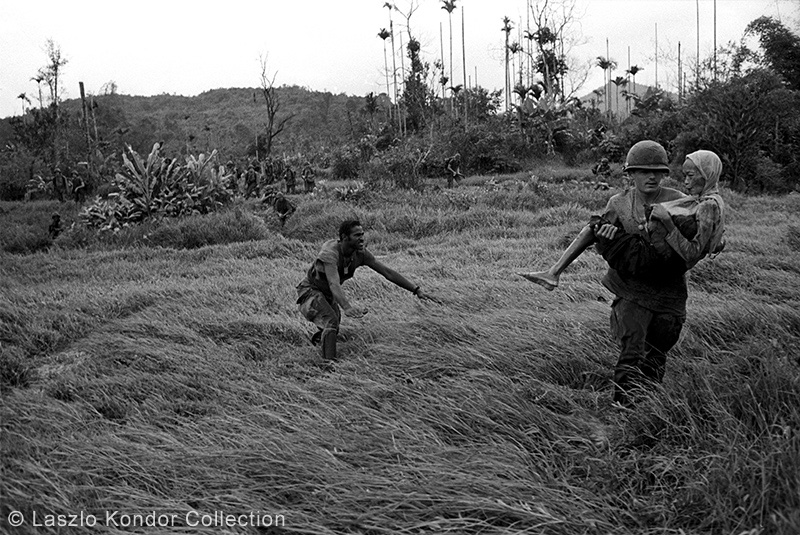
A medic carrying a Vietnamese woman to the chopper. "We entered this abandoned village and someone called out for Doc, as they had found an emaciated old woman who was terrified, shouting and crying. Doc went in. He did not speak Vietnamese and that poor old soul was trembling. The guy had a .45 pistol on his hip. He took it off, dropped it and kicked it away, then knelt and opened his arms. That fragile old lady, weighing about 70 pounds, jumped up like a cat to his lap. Well, that is one way to talk to another human being..."
(With permission of Laszlo Kondor, all rights reserved)
Which Vietnam film would you recommend?
'Platoon'. It is almost the only one I would recommend. The director, Oliver Stone was in Vietnam. He understood what it was all about. That film may be the best to show that madness. Another interesting one is 'Apocalypse Now'. The helicopter assault scene is very authentic, what comes later isn't. When I saw that scene first in the cinema, I was petrified in my seat. I had taken part in similar missions, you know. The atmosphere is the same. You gear up, the choppers arrive, you tell jokes, you get aboard, you sit with your legs out on the side, you enjoy the cool wind into your face and you feel like a giant! You are the meanest, most gung-ho warrior on Earth! The landscape is beautiful, it is daybreak and you feel you'll live forever.
The famous helicopter assault scene
from 'Apocalypse Now'
What was it like coming home from the war?
Before I left Chu Lai, I had run into some of the LRRP’ss to say goodbye. And they noticed that a CIB, the Combat Infantryman Badge was missing from my shirt. 'Where is it?', they asked. I told them I hadn't met the requirements for one. You got one if you finish infantry training, you are assigned to an infantry company and you spend at least 90 days with the company. But I was never assigned. They said it was bullshit. 'Don't move!', and they ran off, then came back, and Serna called formation, they pinned a CIB on my chest! I was and am profoundly proud of that badge and happy I did not get it from bureaucrats; I was awarded by those fellow soldiers who had earned it!

Combat Infantryman Badge
Another 36 hours and I was walking in downtown Chicago. You could say, the mud was still on my boots. It was April, nice weather, and I was there in my khaki uniform. I thought about having a good lunch. There was a crowd on the main street and people kept bumping into me, but I was just walking and thinking to myself. After ten minutes my hands started shaking, I was sweating. I didn’t know why. And I was lucky to remember an old classmate, a Marine lieutenant, who had been in Vietnam. So I called him.
‘John, I’m in trouble, help me.’ I told him about my recent experience.
‘When did you arrive?’
‘Yesterday evening.’
‘Where are you now?’
‘In the middle of Chicago.’
‘Huge crowd, right?’
‘Affirm.’
‘Hang up the phone, grab a cab and go to a park.’
‘But what is this?’
‘Look, you have been conditioned to watch everything, cover all sides in order to survive. And now, you are bumped into and pushed, and your reflexes tell you to kill them!’
This friend of mine had gone through the same. It happened to him while he was sitting in a cinema. He had to climb over other viewers to get out. I was lucky as I had someone to call. But a lot of younger veterans came home, experienced the same and did not know what this was. They went crazy, they started taking drugs… Back in World War Two returning home took three or four weeks, so soldiers had time to re-adjust, to decompose. I hate crowds ever since. I could never really get rid of this.
I had a nice portfolio with the best of my Vietnam photos, from nine months with the Americal Division, but the Army was not finished with me. I was assigned to Hawaii, as a writer to the 25th Division. I was not a writer, so I applied to DASPO, Department of Army Special Photographic Office, and for two years I became a DASPO man.
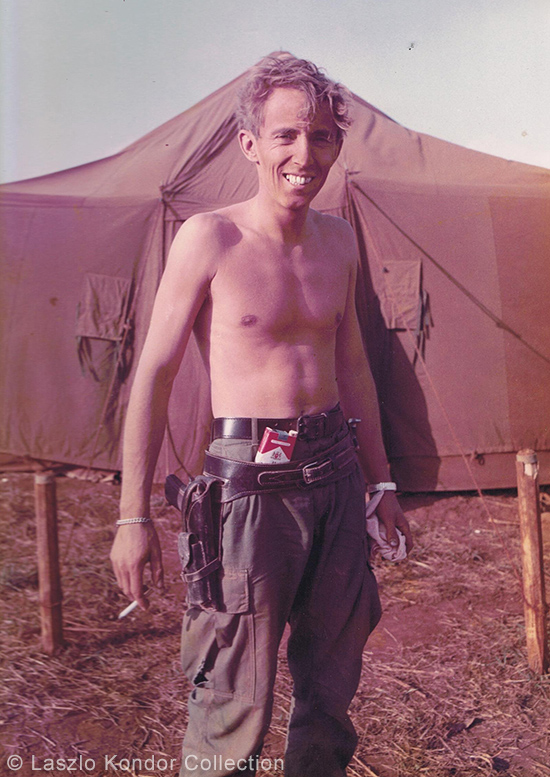
Back in Vietnam as a DASPO photographer,
behind the press tent at Khe Sanh, February 1971
(With permission of Laszlo Kondor, all rights reserved)
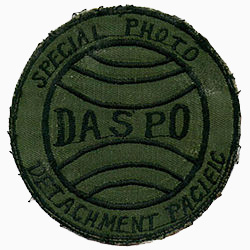 DASPO (Department of the Army Special Photographic Office) was originally founded by President Kennedy. Their job was to provide visual documents for the Congress, the Chief of Staff, the Pentagon and the Army. Laszlo's in the field photographs were impressive, and so he was inducted. They worked in Third World countries, in Japan and Vietnam, even in Alaska. After he was honourably discharged he returned to Chicago, contacted Frank Sullivan who at the time was an assistant to Mayor Daley of Chicago and moving up to a new position as Press Secretary. When he received this post, he called Laszlo asking him to be on his team as the Mayors Personal Photographer.
DASPO (Department of the Army Special Photographic Office) was originally founded by President Kennedy. Their job was to provide visual documents for the Congress, the Chief of Staff, the Pentagon and the Army. Laszlo's in the field photographs were impressive, and so he was inducted. They worked in Third World countries, in Japan and Vietnam, even in Alaska. After he was honourably discharged he returned to Chicago, contacted Frank Sullivan who at the time was an assistant to Mayor Daley of Chicago and moving up to a new position as Press Secretary. When he received this post, he called Laszlo asking him to be on his team as the Mayors Personal Photographer.
The position had not existed before. We had to create this job, define it, make it a needed and important position in the office of the Mayor. By that time I had learned how to go around bureaucracy and how to make myself indispensable. BL (before Laszlo) if the mayor wanted a picture taken, they called the Police Department photographer or the Fire Department photographer, who usually arrived from a fire or a murder scene, smelling or dirty... Or we sometimes used a civilian guy, who was the worst dressed human being I had ever seen. I made a conscious choice: my fellow photographers had perfected this bohemian, unkept, badly groomed look—dirty jeans and dirty t-shirt Well, I was going to dress for success! Three-piece suits! Giorgio Armani or Pierre Cardin. Elegant! You know, that commanded respect! Hey, I was in the office of one of the most powerful Mayors in US History. Afterwards, there was no more "Hey, call that guy with the camera!"
What was your most remarkable assignment here?
The Mayor had a portrait handed out to everybody. It must have been 15 years old, barely bore any resemblance. But he was happy about it and signed it. Sullivan said we needed a decent picture of the affectionately called “old man”. I planned for a studio portrait. Sullivan explained my task, ‘Oh, no, he would never do that. You'll have to get a picture of him—on the run. You could do Vietnam, you can do this!’ This was the bottom line, always... So I followed the Mayor everywhere but Daley was like a perpetual-motion machine. Weeks passed by and I got nothing...
Finally I decided I would shoot him at the weekly press conference. There, at least he was standing in one place. It was now or never! I put my Nikon on a tripod with 300 mm lens and started taking pictures. He was often asked a lot of unpleasant questions, answering with unusable grim faced expressions. The press conference was almost over with Daley about to leave when Jay McMullan, a City Hall regular, lightened the atmosphere, asking him about the dog doodoo problem in the 42nd Ward, a posh neighbourhood. Daley turned back with a gigantic smile on his face and said: ‘Jay! They are dogs, not birds, for Christ's sake, you can't keep them in a cage!’
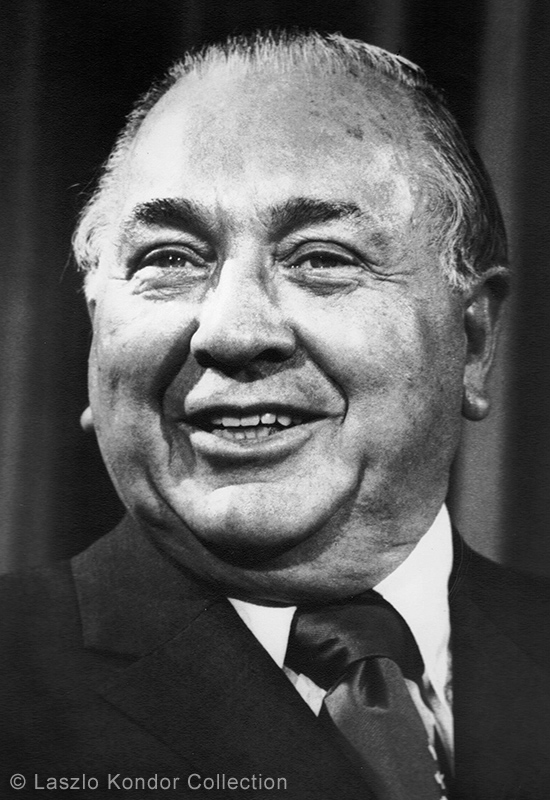
That particular portrait of Mayor Richard Daley...
(With permission of Laszlo Kondor, all rights reserved)
That was it. I knew I had it! I ripped the film out of the camera and ran! I told the film processing house I wanted a rush one-hour development with five 50x60 enlargements. Which picture turned out to be the one? The last one! I ran to show it to Sullivan. He just took a look at it and said: ‘My God! You got it!’ And they would use that portrait everywhere for the rest of the Mayors professional life.
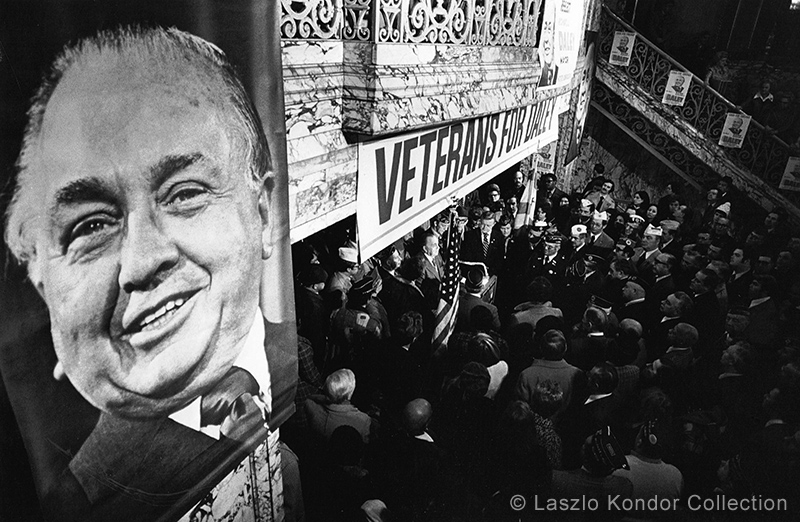
...which was to be used everywhere for years.
(With permission of Laszlo Kondor, all rights reserved)
As Mayor Daleys photographer he took pictures of the numerous celebrities that came to meet the Mayor including Luciano Pavarotti, Margaret Thatcher, Karol Wojtyla, Henry Kissinger, Frank Sinatra, Bob Hope, John Wayne or Leonard Bernstein. Years later, he set up his own commercial studio (he traveled around half the world with Motorola), specialising in people, fashion and advertising photography until 1996. Lots of politicians continued to come to him for they had seen Daley's picture and believed that a good portrait would do good to their careers. Digital photography arrived in the late 1990s. He was from the film and print generation of photographers, a traditionalist, and did not feel like adapting to this new technology. Today, although he has a digital camera, he rather sticks to gardening. Recently he has been invited as a guest artist talking about his life in photography and his experiences in Vietnam, at high schools and universities in Hungary. He likes talking to young people.
Will you go back to photography again?
God knows. Probably not. My wife and I have been working on an exciting project. Today, retired, my perspective has changed from creating the work to striving to preserve and introduce the images to my fellow Hungarians. I am in search of an institution that would consider a comprehensive exhibition, and a safe haven for the materials and hope to make a donation or gift to the nation. I am proud of my oeuvre. Maybe it will be the Hungarian National Museum in Budapest. My Vietnam images are in the permanent collection of the NVAM, National Veterans Art Museum in Chicago and my political historical work is in the Richard J. Daley Library at UIC, University of Illinois Chicago.
I’m 76, I had a good life. It was not an easy one, but it was good. And it is not over yet!
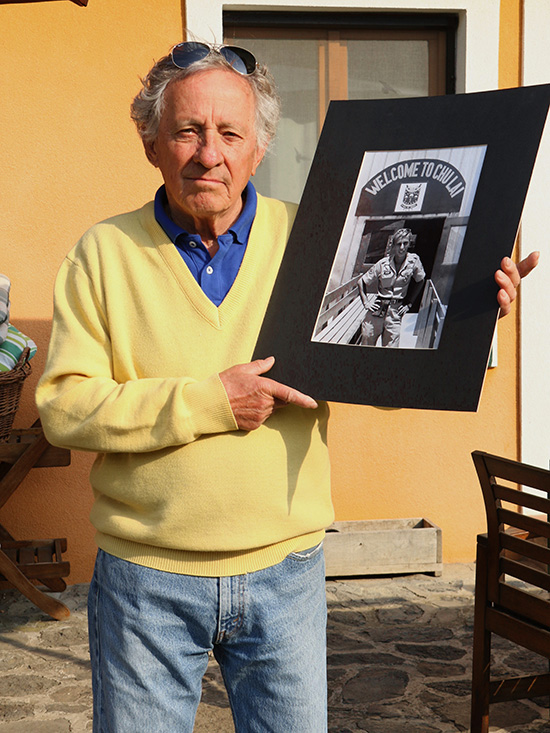
Laszlo Kondor, 2017: he is holding his portrait
taken just before his departure from Vietnam
I wish to say thank you to Laszlo Kondor and his dear wife for seeing me and sharing his experiences, and Peti, a loyal reader who joined us.

